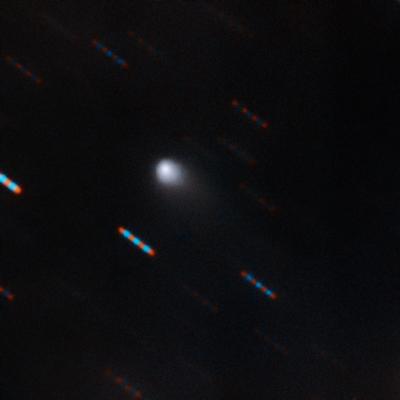
Credit: Gemini Observatory/NSF/AURA
The first-ever comet from beyond our Solar System has been successfully imaged by the Gemini Observatory in multiple colors. The image of the newly discovered object, denoted C/2019 Q4 (Borisov), was obtained on the night of 9-10 September using the Gemini Multi-Object Spectrograph on the Gemini North Telescope on Hawaii’s Maunakea.
“This image was possible because of Gemini’s ability to rapidly adjust observations and observe objects like this, which have very short windows of visibility,” said Andrew Stephens of Gemini Observatory who coordinated the observations. “However, we really had to scramble for this one since we got the final details at 3:00 am and were observing it by 4:45!”
The image shows a very pronounced tail, indicative of outgassing, which is what defines a cometary object. This is the first time an interstellar visitor to our Solar System has clearly shown a tail due to outgassing. The only other interstellar visitor studied in our Solar System was ‘Oumuamua which was a very elongated asteroid-like object with no obvious outgassing.
The Gemini observations used for this image were obtained in two color bands (filters) and combined to produce a color image. The observations were obtained as part of a target of opportunity program led by Piotr Guzik and Michal Drahus at the Jagiellonian University in Krakow (Poland). The research team has submitted a paper for publication.
C/2019 Q4 is currently close to the apparent position of the Sun in our sky and is consequently difficult to observe due to the glow of twilight. The comet’s hyperbolic path, which is evidence of its origin beyond our Solar System, will bring it to more favorable observing conditions over the next few months.
C/2019 Q4 was discovered by Russian amateur astronomer Gennady Borisov on 30 August, 2019.
###
ABOUT THE GEMINI OBSERVATORY
The Gemini Observatory is a facility of the National Science Foundation (NSF-United States), the National Research Council (NRC-Canada), the Comisión Nacional de Investigación Científica y Technológica (CONICYT – Chile), the Ministério da Ciência, Tecnologia e Inovação (MCTI – Brazil), the Ministerio de Ciencia, Technología e Innovación Productiva (MCTIP – Argentina), and the Korea Astronomy and Space Science Institute (KASI – Republic of Korea), operated under cooperative agreement by the Association of Universities for Research in Astronomy, Inc. (AURA).
The international Gemini collaboration provides access to two identical 8-meter telescopes. The Frederick C. Gillett Gemini telescope is located on Maunakea, Hawai’i (Gemini North) and the Gemini South telescope is on Cerro Pachón in central Chile; together the twin telescopes provide full coverage over both hemispheres of the sky. The telescopes incorporate technologies that allow large relatively thin mirrors, under active control, to collect and focus both visible and infrared radiation from space. The Observatory provides the astronomical communities in each of the five participating countries with state-of-the-art astronomical facilities that allocate observing time in proportion to each country’s contribution. In addition to financial support, each country also contributes significant scientific and technical resources.
Contacts:
Peter Michaud
Gemini Observatory, Hilo HI
Email: [email protected]
Cell: (808) 936-6643
Desk: (808) 974-2510
Michal Drahus
Jagiellonian University, Krakow (Poland)
Email: [email protected]
Piotr Guzik
Jagiellonian University, Krakow (Poland)
Email: [email protected]
Andy Stephens
Gemini Observatory
Email: [email protected]
Media Contact
Peter Michaud
[email protected]
Original Source
https:/




